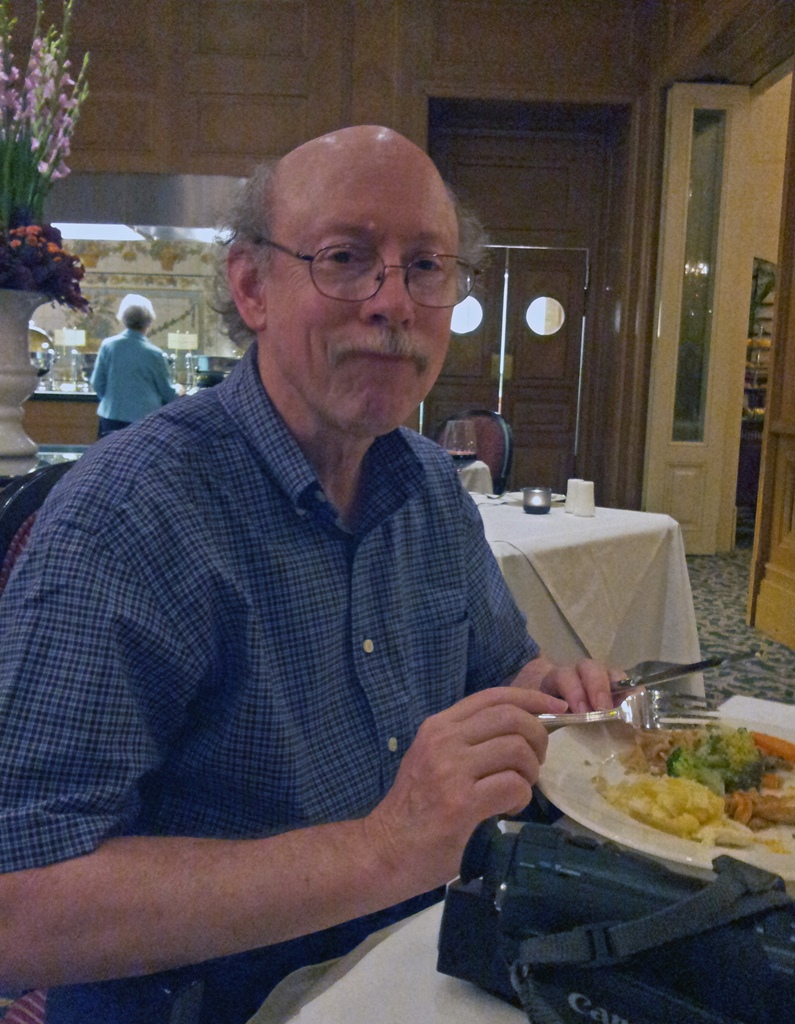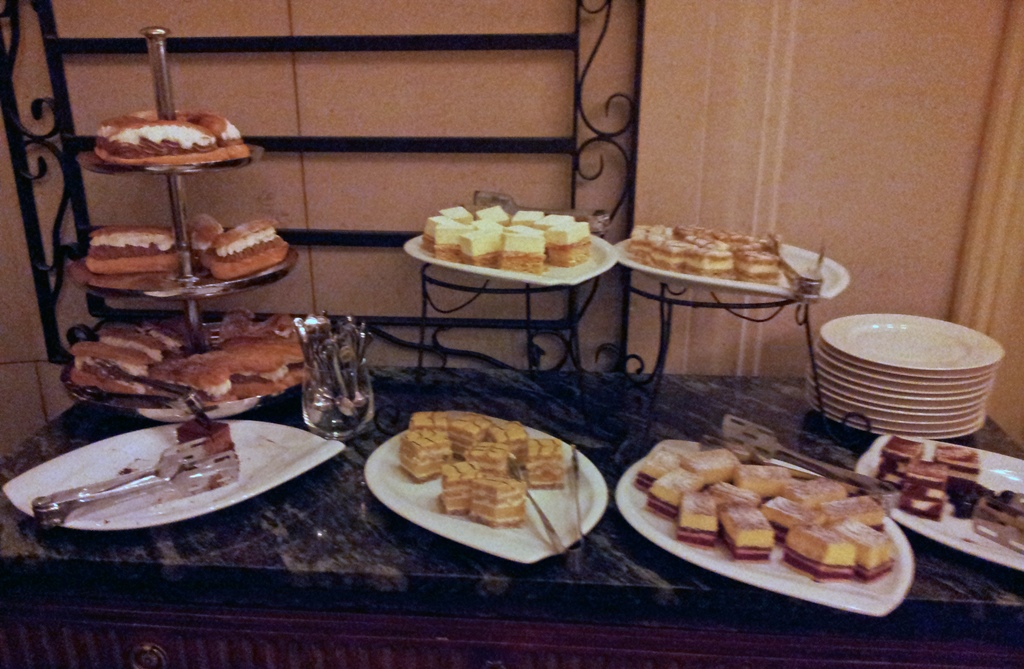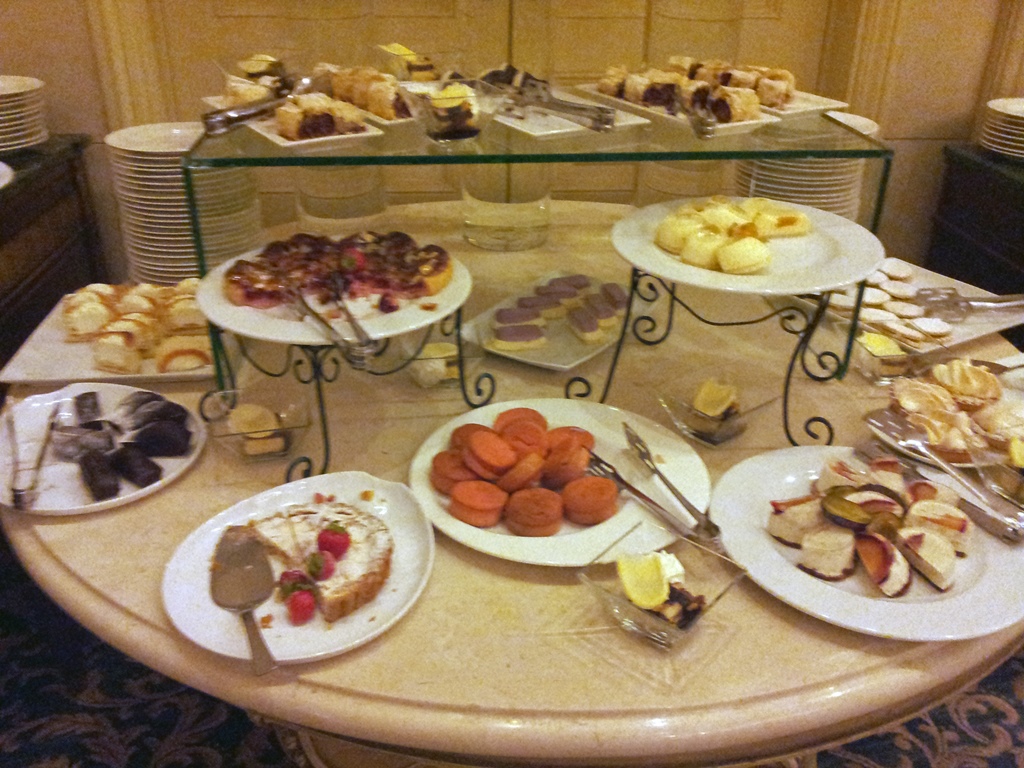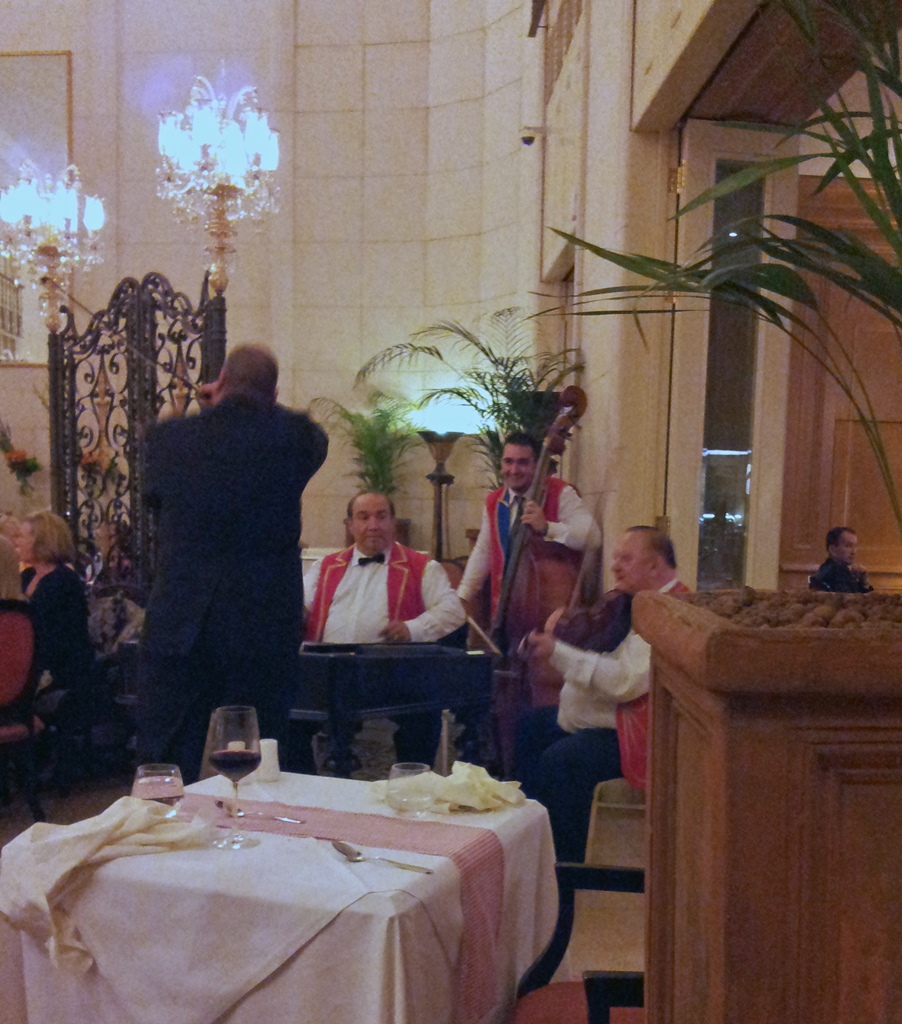Note: A YouTube companion video for this page can be found
here.
On leaving the hotel in the morning to go visit St. István's Basilica and the Museum
of Fine Arts, we picked up an area map at the front desk, and the man who gave us the
map told us about a "Hungarian cultural experience" that would be taking place in the
hotel that evening. This experience would include music and dancing, as well as a
dinner featuring some of the local cuisine. We'd been thinking about finding a
performance like this somewhere, but were not sure where we might find one. We felt
this one to be a little on the pricey side, but the convenience and the inclusion of
food overcame our chintziness, and we signed up.
At the appointed hour we appeared at the appointed place (the same room off the lobby
that was used for breakfast) and were seated at a table in one of the side rooms with
a view into the main room. In due time, dinner was announced, and everyone lined up
at a buffet table to serve themselves some of the interesting-looking food.
Unfortunately I don't remember too many of the details, aside from goulash (of
course), some of the local fish and some salads. I do remember going back for a
second plateful and finding that all of the main courses had been swept away and
replaced by desserts. This would have delighted me when I was about ten years old,
but in somewhat advanced adulthood I was sort of hoping for a little more protein
first. Nevertheless, I didn't want to behave like a gauche American, and I was able
to force down more delicious desserts than I otherwise might have.

Bob Eating Dinner

Desserts

Desserts
While we were dealing with the food, we were being entertained by the four-piece
house band, which consisted of four not-so-young but sharply attired musicians wielding
a lead violin, a second violin (rhythm violin?) or possibly a viola, a stand-up bass
and a cimbalom. You might be asking yourself what a cimbalom is (I know we were).
It's a member of the dulcimer family, apparently ubiquitous in presentations of
traditional Hungarian music, which in a way could be thought of as a piano without the
keyboard. This might not make much sense at first – after all, what's a piano without
a keyboard? The answer, of course, is a wooden box full of strings. In a piano
(non-electronic), each key on the keyboard activates a small felt-covered hammer which
hits one or more (up to three) strings to produce the desired note. When playing a
cimbalom, as there is no keyboard, the musician must hit the strings directly, using
two "wands", each of which has a fabric-wrapped hammer on the end of it. And as the
strings are directly accessible, it's also possible to pluck them, which is done during
some performances. This might sound kind of primitive, but a good cimbalomist (like
the one in the house band) can accomplish amazing feats of musicianship and dexterity.
There's video below in which you can see the use of a cimbalom by the house band, but
here's a link to a YouTube
video in which you can get a better look at the instrument in action. The video is of
an ensemble performance of Rimsky-Korsakov's Flight of the Bumblebee, with heavy
cimbalom emphasis. Note the use of the damping pedal.

Band Performing

Hungarian Dance No. 5 (Brahms)

Band, featuring Cimbalom
When people were mostly done eating, the dancers came out. There were six of them,
three of each available gender, and they performed different Hungarian dances with
different combinations of personnel. The view from our side room wasn't the best, as
the performances were focused on the bulk of the audience, which was sitting in the
main room. Also, the band was often between us and whoever was dancing on the right,
blocking our view. I've done my best to identify the dances performed in the following
videos, but I wouldn't be surprised if some of my guesses proved to be incorrect.
First up was a dance for guys only, called the Legényes, which originated in
Transylvania (now in Romania) and features a lot of boot-slapping.
Boot-Slapping Dance (Legényes)
Another dance was the Csárdás, which is a pairs dance which starts out at a fairly
relaxed tempo but gradually accelerates, until it becomes quite the workout by the
end of the song. The dance dates back to the 18th Century, and the accompanying
musical style was explored by famous composers such as Liszt, Brahms, Strauss and
Tchaikovsky.

Csárdás Dance

Another Csárdás Dance
This was followed by the Üveges, a girls-only dance involving the balancing
of flasks of wine on the performers' heads while they dance and sing. The hotel
dancers used large Erlenmeyer-style flasks with big, flat bottoms. This seems to
be commonly the case for this dance (based on several YouTube videos), and the
balancing act seems difficult enough with such flasks, but sometimes dancers have
been known to use actual wine bottles. Our dancers weren't that advanced, but they
danced admirably and seemed to be having a good time, and when they were finished
they walked around in the crowd and balanced the bottles on the heads of female
audience members as they posed for pictures.

Bottle Dance (Üveges)

Audience Participation
After a costume change to more colorful, Gypsy-like attire, the dancers reappeared
and did some more dances which I haven't been able to identify. First, the guys
went out and did a dance in which they used wooden spoons as percussion instruments.
Then they were joined by the women, who came out with tambourines.

Backstage, Guys Dancing

Wooden Spoon Dancing

Tambourine Dancing

Finale
After the finale, the dancers started dancing with some of the audience members,
who also started dancing with each other, and the band started taking requests, for
a fee. The cimbalom player appeared to be the band accountant.
Accounting
The dancing was still going on when we decided to go back to our room. We were tired
and jet-lagged, and the songs being requested reflected the age of the audience members,
which generally exceeded ours (if you can imagine such a thing) and did little to keep
us awake. My stomach ended up being unhappy that night, maybe from the jetlag, or maybe
from eating too much dessert, but it recovered by morning. Good thing, as we had
ambitious plans for the next day, starting with a visit to the castle on the hill in
Buda.
















